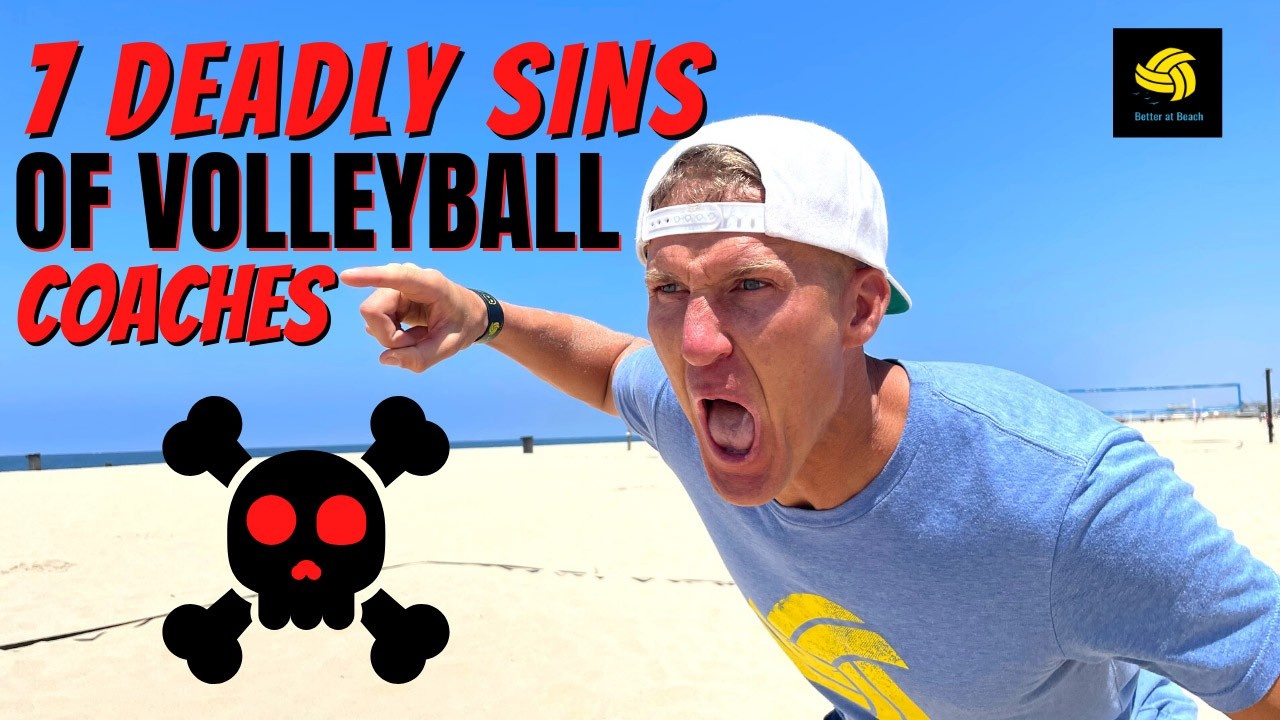
7 Deadly Sins of Volleyball Coaches
There are a lot of great volleyball coaches out there. Think Stein Metzger, Dain Blanton, Jenny Johnson Jordan, John Mayer, Betsi Flint, Mark Burik, Brooke Niles, Brandon Joyner -- the list could go on and on and on.
There are also a lot of not so great volleyball coaches out there, but we're not going to name names. We're just going to leave it at the fact that we're all human and, well, sometimes those human fallacies become very apparent when we're coaching. But if you'd like to join the first list, the one with some of the best coaches in the country currently, here are the seven deadly sins of volleyball coaches you'll want to avoid.
1. Monday Morning Coach
Have you ever watched your favorite football team -- say, the Baltimore Ravens -- and explode off your coach, screaming obscenities at Lamar Jackson for throwing an interception in the AFC Championship Game? (me neither...)
How could he not see the defensive back?
Didn't he see JK Dobbins wide open in the flat?
We've all been there, in some form or the other. And, as coaches, it's a bad place to be. Little good comes out of telling your players something to the effect of: "How did you not see that high line coming?" There's no instruction in that, just a putdown of your player that's retroactive and not at all helpful.
"Too many coaches think they know what is going to happen," AVP professional beach volleyball player and excellent coach, Mark Burik, said. "So what they say is what just happened and they only give corrections for things that happen after they happened and that’s not a good way to coach. All you’re doing is pointing out mistakes and fixing them retroactively."
If you're a Monday Morning Coach, how do we fix this issue?
"If you are a good coach you should develop some goals," Burik said. "You should give your player a goal and stick to it. That shouldn’t change every point based on what happened."
2. Helicopter Coach
There is so, so, so much to be learned and covered in the sport of beach volleyball. We could go on all day long about the subtle nuances of setting: Where your feet should be, how your hands should feel, where your chest should be pointed, how far off the net you should be, how high the set should be, if you should run a back set with the wind, if you should lower the set, if if if...
And we're just talkin' bout setting, y'all. Not a match, not a match -- setting.
There's so much information to learn, and one of the worst things a coach can do to a player is to dump it all on them at once, filling their brains with so much information and keys and things to remember that everything begins to overflow and spill all over the sand.
"We’ve all experienced those coaches who throw a million different keys, so many different ideas, while you’re playing in the point," Better at Beach coach Brandon Joyner said. "You don’t even have a second to think about what you’re trying to accomplish. If you’re a coach, remember, you need to allow your players to work on one thing at a time. Make sure when you’re giving feedback, you’re quieting the voice in your head to fix everything at once and concentrate on making that one fix."
Simpler is better. Start small and build from there.
3. Silent But Deadly Coach
They say that 70 percent of our communication is nonverbal. Whether you believe that figure or not, the moral of the story is this: Nonverbal communication is a huge element of how we interact with one another. As a coach, you need to take that into account. It doesn't matter if you're screaming at your players or students -- shaking your head, kicking the sand and punting balls has the same effect.
The most important aspect of coaching to remember is that you're on the same team as your players. It's your job to build them up, especially when they're in competition. When they see you making negative facial expressions, throwing tantrums, shaking your head in disgust, it's going to have an adverse effect on their psyche and game.
Keep your nonverbal communication in mind.
4. The Good Vibes Coach
Ok, we admit: If this is your problem, it's a decent problem to have. There are a number of coaches out there who are just so positive, so over the top nice, so complimentary, that nothing is actually gleaned.
"It is awesome to be positive and a cheerleader for your team but don’t let that distract you from actually giving feedback," Brandon Joyner said. "Stay positive, but make sure to give actual feedback instead of just ‘Good touch! Good try! Good hustle!’ Still concentrate on technique and give good feedback."
You can couch your feedback in positivity -- but you do need to ensure your players are getting the information they need. If they're shanking passes, they need to know why, even if they're giving their best effort. Remember: They came to you to improve, not get their ego stroked.
Be positive -- but effective.
5. The Screamer Coach
Let's all take a deep breath and calm...down.
Feels nice, doesn't it?
It will for your players, too.
"If you’re a coach, calm yourself down," Mark Burik said. "Find a good way to analyze, see what’s going on, assess the room to see if you need to be angry in that moment or if it’s going to be better for you to be positive to your players."
Even if you have reason to be angry, you can find a way to channel that anger into an effective means of communication. Let your players know what went wrong, why it went wrong, and, most importantly, how they can fix it. Do this calmly, in a tone that won't send them running to the hills -- or to another coach!
6. The Mad Scientist Coach
Some coaches love, absolutely love, complicated drills. And there's nothing wrong with that! But before your begin a drill, you need to ensure everybody understands the drill, their role in the drill, and the purpose of the drill...or else all chaos will inevitably ensue.
"When you’re explaining a drill, especially when it’s a multi-contact drill, start by setting the players up on the court and give each person their own specific instruction," Brandon Joyner said. "Then you can go about the drill doing what you aim to accomplish."
Multi-contact drills are so, so, so very useful for ball control and getting lots of touches. But they can be complicated the first few times around. Take that into account and spend a few extra minutes explaining the drill. Then get into it so everyone can -- say it with me now -- get Better at Beach!
7. The Back In My Day Coach
Guys and gals, we hate to break it to you, but your players don't care about your playing days in the '80s and '90s. They just want to get better at volleyball. Don't waste precious practice time regaling legends of playing against Karch Kiraly's cousin's best friend's sister-in-law. If your players ask you about your days and experiences as a player, do it off the court.
Practice time is for practice.
Practice is for getting Better at Beach.





